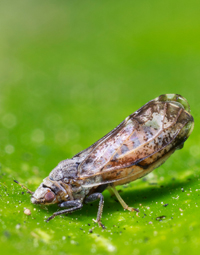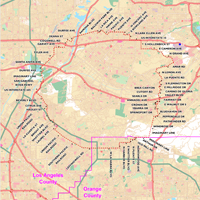
The Situation: On Thursday April 5 2012, after about a week of testing, the California Department of Food and Agriculture (CDFA) removed a pumelo tree with a lemon graft from Hacienda Heights in Los Angeles County after the tree and an Asian citrus psyllidfound on the tree both tested positive for a lethal citrus disease, Huanglongbing(pronounced Wong-Long-Bing [HLB]). HLB is caused by a bacterium, and HLB-causing bacteria kill citrus by affecting the food transportation systems of infected trees. There is no known cure for the disease, and the HLB-bacterium does not pose a threat to humans, pets, or other plants.

The Problem: Huanglongbing, also known as yellow shoot disease, yellow dragon disease (these are English translations from the Chinese Huanglongbing indicating that the leaves of infected citrus appear an irregular mottled yellow color) or citrus greening (because fruit don’t ripen properly and remain green in areas) is spread from tree-to-tree by the Asian citrus psyllid (ACP), This small insect acts as a flying syringe carrying bacteria in its needle-like mouthparts and when infected psyllids feed on citrus they inject bacteria into trees. The disease can also spread by grafting infected branches onto healthy trees. The possibility that an infected branch was brought into California and used for a graft is being investigated.
Infected trees typically die within 5-8 years after being infected, but disease symptoms may take as long as 2 years to become obvious. This long latency period provides ample time and opportunities for ACP to visit infected plants, feed on them, acquire the bacteria and fly onto healthy trees to feed which puts these trees at risk of becoming infected with bacteria.
HLB has been a particularly devastating disease problem in Florida. In 2005, HLB was first detected and it was estimated that 10% or 60,000 acres of citrus was destroyed by HLB by 2009, just four years after the first find. This reduction of citrus acreage in Florida corresponded with an estimated loss of 6,600 jobs, $1.3 billion in lost revenues to growers, and $3.6 billion in lost economic activity associated with the citrus industry in Florida.
The commercial citrus industry is worth about $1.2 billion in California and about 300,000 acres are farmed.
Where are ACP and HLB in the USA? ACP and HLB are present in Florida, Texas, Louisiana, Georgia, and South Carolina. ACP is present in Arizona, Mississippi, and Alabama, but HLB has not yet been found. In California, ACP was first found in San Diego and Imperial Counties in 2008. Since this initial detection ACP has been found in Ventura, Orange, Santa Barbara, Los Angeles, Riverside, and San Bernardino Counties. ACP populations at this time are heaviest in Los Angeles County.

The Response: On April 5 2012, the CDFA held an open house meeting at Industry Hills Expo Center in the City of Industry. The purpose of the meeting was to provide the public with information on HLB and ACP and to respond to requests to examine citrus with disease symptoms that look suspiciously like HLB. Additionally, all citrus within an 800 meter (about 2,400 feet) radius of the infected tree have been treated with insecticides by the CDFA to kill any Asian citrus psyllids that may be carrying bacteria that cause HLB. A 93 square mile quarantine has been established in Hacienda Heights in Los Angeles County and part of northern Orange County. This quarantine prohibits the movement of all citrus nursery stock out of this area in case they are infected with HLB and these plants, if infected, could start new disease infestations in different areas of California. Any fruit from residential properties must not be moved to other areas in case ACP or HLB accidentally hitch-hike into new areas on this fruit.
What is the Future for Citrus in California? Following the find of HLB in Hacienda Heights there has been concern that a massive citrus die off in gardens is now imminent. This is unlikely because surveys have failed so far to find more than one tree infected with HLB. Further, it is unlikely that trees dying from HLB be initially widespread, it is probable that if there are other HLB infected trees in California, they are uncommon and widespread. The difficult problem facing the CDFA and USDA is finding these infected trees (should they exist) and eradicating them before ACP finds them, feeds, acquires HLB bacteria, and spreads them to healthy citrus. Because the disease is slow in killing trees, the loss of trees will be slow, and probably patchily distributed in the early stages of the spread.
What Can you Do to Help? The CDFA has set up a Pest Hotline 1-800-491-1899 and a Report-a-Pest website http://www.cdfa.ca.gov/plant/reportapest/ to help in the fight against invasive species coming into California.
Recent News Articles
Los Angeles Times: Gardeners’ Common Bond May Have Introduced Deadly Disease.
Los Angeles Times: San Gabriel Valley Homeowners Swarm to Meeting about Citrus Disease